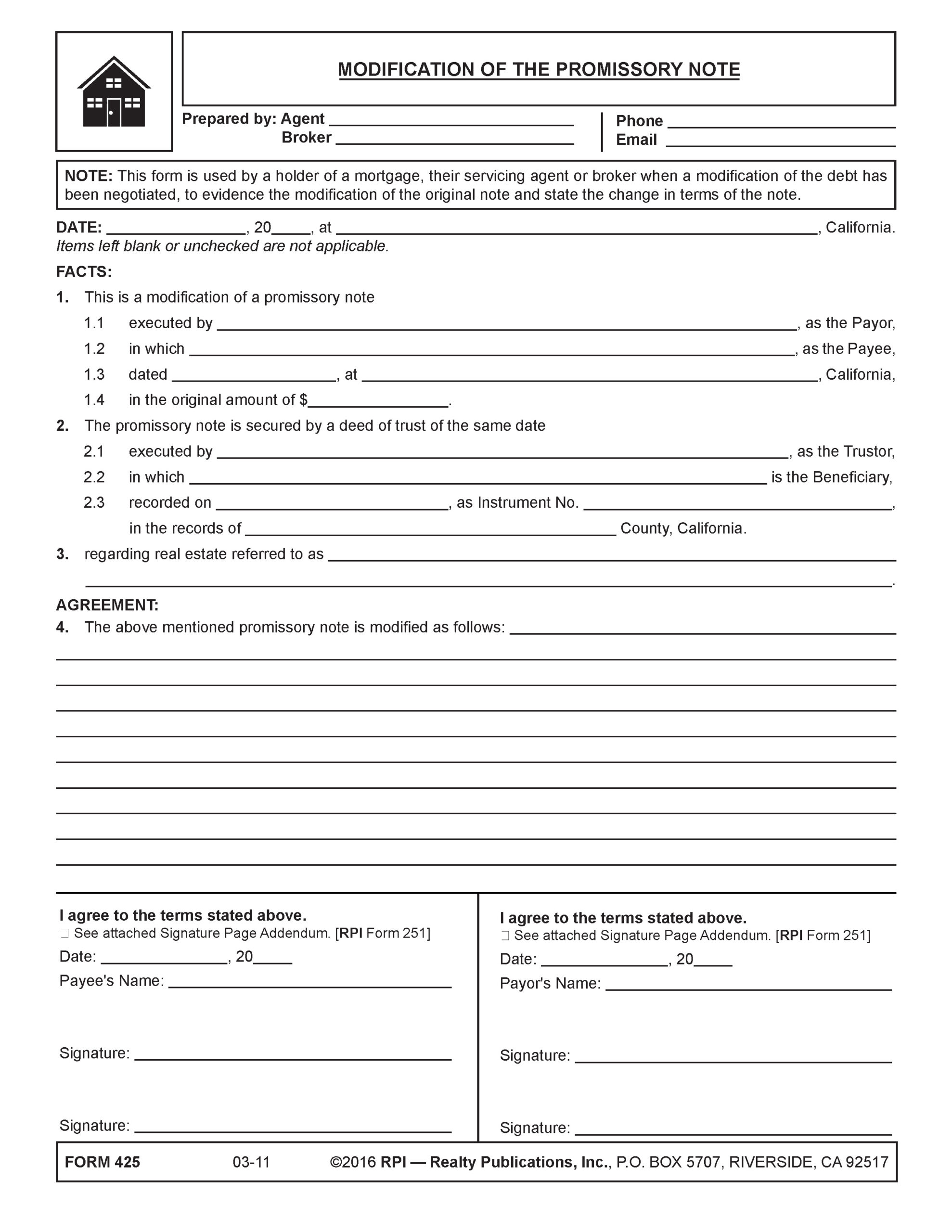This form is used by a holder of a mortgage, their servicing agent or broker when a modification of the debt has been negotiated, to evidence the modification of the original note and state the change in terms of the note. 
Modifying the note
A note, sometimes called a promissory note, contains the borrower’s promise to pay the lender or carryback seller — called a mortgage holder — the principal amount of the debt incurred, plus any interest.
Critically, the note is not the debt itself, but evidence of the existence of a debt created in an underlying transaction, such as the lending of money or installment sale of property.
In contrast, provisions in a trust deed, besides referencing the note and describing the real estate which secures the debt, primarily addresses the maintenance and preservation of the mortgage holder’s security interest in the real estate granted by the trust deed. Together, the note and trust deed document what is colloquially called a mortgage.
During the life of a mortgage, the mortgage holder and owner of the mortgaged property may agree to modify, add or rescind one or more of the note provisions. [See RPI e-book Real Estate Finance, Chapter 7]
Any change in the terms of a note requires:
- mutual agreement between the property owner and the mortgage holder; and
- consideration given in exchange for the modification, with the exception of bankruptcy. [See RPI Form 426]
Modifications of a mortgage usually arise out of a financial necessity experienced by the owner of the mortgaged property. Conversely, a carryback seller may incur profit taxes on receipt of a payoff of the mortgage which may prompt the seller to bargain for a modification to extend the time for payoff, and thus payment of profit taxes.
Negotiating to modify mortgage terms
The modification of a note is controlled by California contract law. Thus, a written contract — in this example, the note evidencing a debt — is modified by:
- a written agreement; or
- an oral agreement. [Calif. Civil Code §1698]
However, for an oral modification to be enforceable, both the mortgage holder and the property owner need to execute the oral agreement by taking action to perform the agreement. To be certain of the terms as modified, the modification needs to be memorialized in a writing.
A property owner best initiates formal negotiations – following an oral discussion – by filling out a form submitted to the mortgage holder as their written offer to modify the note. As with all forms, the form functions as a checklist of issues a well-informed agent considers when negotiating a transaction.
When filled out, the agreement to modify a promissory note sets forth the terms sought by the person initiating the modification effort. A real estate agent traditionally facilitates negotiations with the mortgage holder on behalf of the owner. [See RPI Form 426]
Once the agreement to modify has been negotiated to set the new terms for payment and rates, the agent, broker or escrow officer prepares a Modification of the Promissory Note form. It is the modification form, a sequel to the agreement to modify form, which actually changes the terms of the existing mortgage from those in the original note, called performance. [See RPI Form 425]
Provisions in the modification form act to:
- identify the note which is being modified;
- name the parties to the mortgage; and
- identify the trust deed and the mortgaged property involved.
To complete the paperwork called for in the agreement, the signed modification form is physically attached to the note as an allonge – stapled. The terms of the modification then become part of the original note.
Analyzing the modification of the promissory note
A mortgage holder, their servicing agent or broker uses the Modification of the Promissory Note published by RPI when a modification of the debt has been agreed to through negotiations. The form provides the mortgage holder, agent or broker evidence of the modification of the original note and states the change in terms of the note. [See RPI Form 425]
The Modification of the Promissory Note identifies:
- the promissory note being modified [See RPI Form 425 §1];
- the trust deed securing the promissory note [See RPI Form 425 §2];
- the liened real estate [See RPI Form 425 §3];
- the modifications to the promissory note [See RPI Form 425 §4]; and
- signatures of the mortgage holder and owner. [See RPI Form 425]
Form navigation page created 12-2023.
Form-of-the-Week: Form-of-the-Week: Agreement to Modify a Promissory Note, and Modification of the Promissory Note — Forms 426 and 425
Feature Article: Changing the terms of a mortgage
Article: Form 426 – Modification of the note
Video: Evidence of the Debt
Video: Introduction to Promissory Notes
Book: Real Estate Finance, Chapter 7: Modifying the mortgage note













